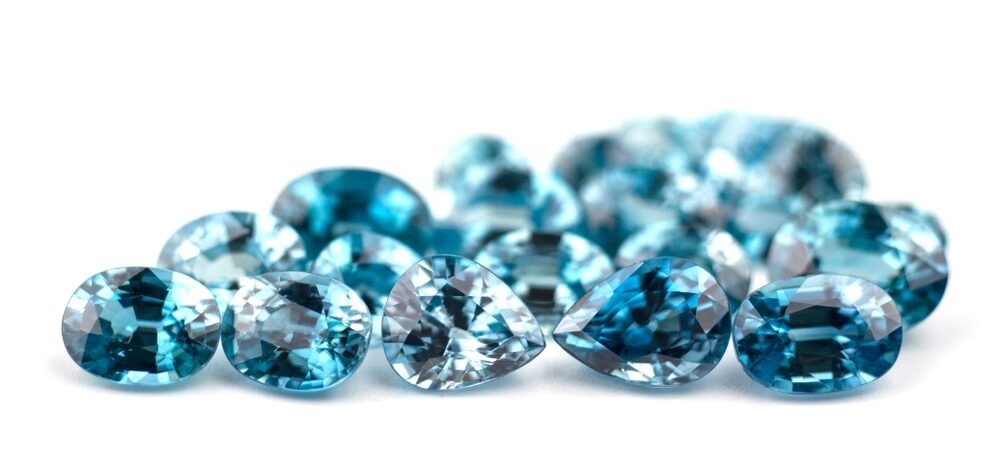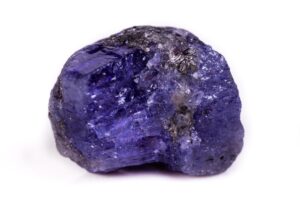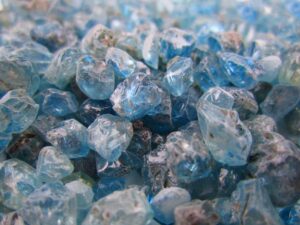Ranging from the rainbow varieties of zircon, to the blue to bluish purple hues of tanzanite, to the intense blue and green of turquoise- the December birthstones are a treat for anyone looking for blue hued gemstones. Let us dive into the information about the three gemstones of the month December!

Zircon- History
The word “zircon” is believed by some scholars to have been derived from the Persian word zargun which means gold coloured, while others believe it to have originated from the Arabic word zarkun which means vermillion or cinnabar. During the Middle Ages, zircon was believed to lull one off into deep sleep and also scare off evil spirits. In the Victorian era, blue zircon was highly popular, fine specimens of which are still found in the pieces of jewellery dated back to the 1880s. In the Hindu religion, zircon is one of the nine gems of the Navratna, which are believed to protect, bring wisdom, wealth, and health to the wearer.
Zircon is majorly found in a central Sri Lankan region called Elahera. Other sources of zircon in the world include Australia’s Zircon Hill, and Vietnam, Myanmar, Cambodia.
Zircon- Characteristics
Zircon is usually located & found near sapphire sources. It has a broad colour palette that includes blue, green, yellow, orange, red, and brown. This December birthstone has been confused with diamond for centuries as colourless zircon shows brilliant flashes of multicolour light. It ranges from 6 to 7.5 on Mohs scale of hardness.
Zircon- Cleaning & Caring
Zircon is usually stable when exposed to light, but after prolonged exposure to bright light some heat-treated zircons tend to revert to their original colours. Exposure to chemicals does not alter or harm this December birthstone. Zircon is sensitive to friction, hence one must avoid wearing it while engaging in rough activities. You can clean your zircon using mild soap, soft brush, and warm water. Steam or ultrasonic cleaners are not recommended for cleaning Zircon.

Tanzanite- History
Tanzanite was discovered in the 20th century in Tanzania. The name is derived in the honour of the country of its origin. Tiffany & Co. believed in the international appeal that this December birthstone had, and became its main distributor by also launching a major advertising campaign in 1968 to promote it.
Tanzanite is only found in the Merelani Hills of northern Tanzania in the world. This is the only place on earth where tanzanite is mined commercially.
Tanzanite- Characteristics
Tanzanite ranges from rich pure blue colour to violet. It is popular for its deep saturated colours, out of which its rich blue is considered the most valuable. Tanzanite is resistant to common chemicals, heat, and light. However, it may crack if exposed to sudden temperature changes or very high temperatures. Most tanzanites are originally brownish zoisite, which are then heat treated to produce the blue and violet hues. It ranges from 6 to 7 on Mohs scale of hardness and is a quite durable gemstone.
Tanzanite- Caring & Cleaning
Wearing a tanzanite in a ring is not recommended on a daily basis, as it is best set in pendants and earrings. Cleaning this December birthstone with warm soapy water is the best way, while using steam and ultrasonic cleaners is highly unrecommended.
Turquoise- History
Turquoise is a gemstone that has been cherished for millennia, with the ancient Egyptian rulers adorning themselves with it, including the pharaohs. It was more than 3000 years ago that the Chinese artisans carved it. Since the 13th century, turquoise has been believed to protect the wearer from falling. In the Hindu religion, it was believed that seeing this December birthstone after beholding the new moon, would ensure abundant wealth! Turquoise has always played a significant role in the lives of Native Americans. They believed that attaching turquoise to a firearm or bow would make the aim more accurate. This December birthstone is considered a national treasure in Tibet, which is believed to bring good fortune, sound health, peace, and protection from evil to the wearer. Turquoise is also found in the jewellery of modern royalty.
China is the largest producer of turquoise today. It has been mined in Iran’s Nishapur district for over 1000 years. Other major sources include Arizona, Nevada, and Mexico in the US.

Turquoise- Characteristics
Turquoise ranges from blue to green colours, often having veins of matrix running through it. These veins are formed by the remnants of rock in which they are formed. Turquoise ranges from 5 to 6 on Mohs scale of hardness. Some turquoise are treated to improve their appearance, durability, and polish. They can be chemically enhanced or dyed to gain better colour and enhanced hardness. Exposure to high heat can cause breakage and discoloration in turquoise.
Turquoise- Cleaning & Caring
Turquoise is stable to light, but can get affected by high temperatures. Certains chemicals, acids, cosmetics, as well as perspiration can damage turquoise. To safely clean turquoise jewellery, use warm soapy water. It is not recommended to clean this December birthstone using steam or ultrasonic cleaners.
Stay tuned for more information on birthstones and their interesting trivia!


